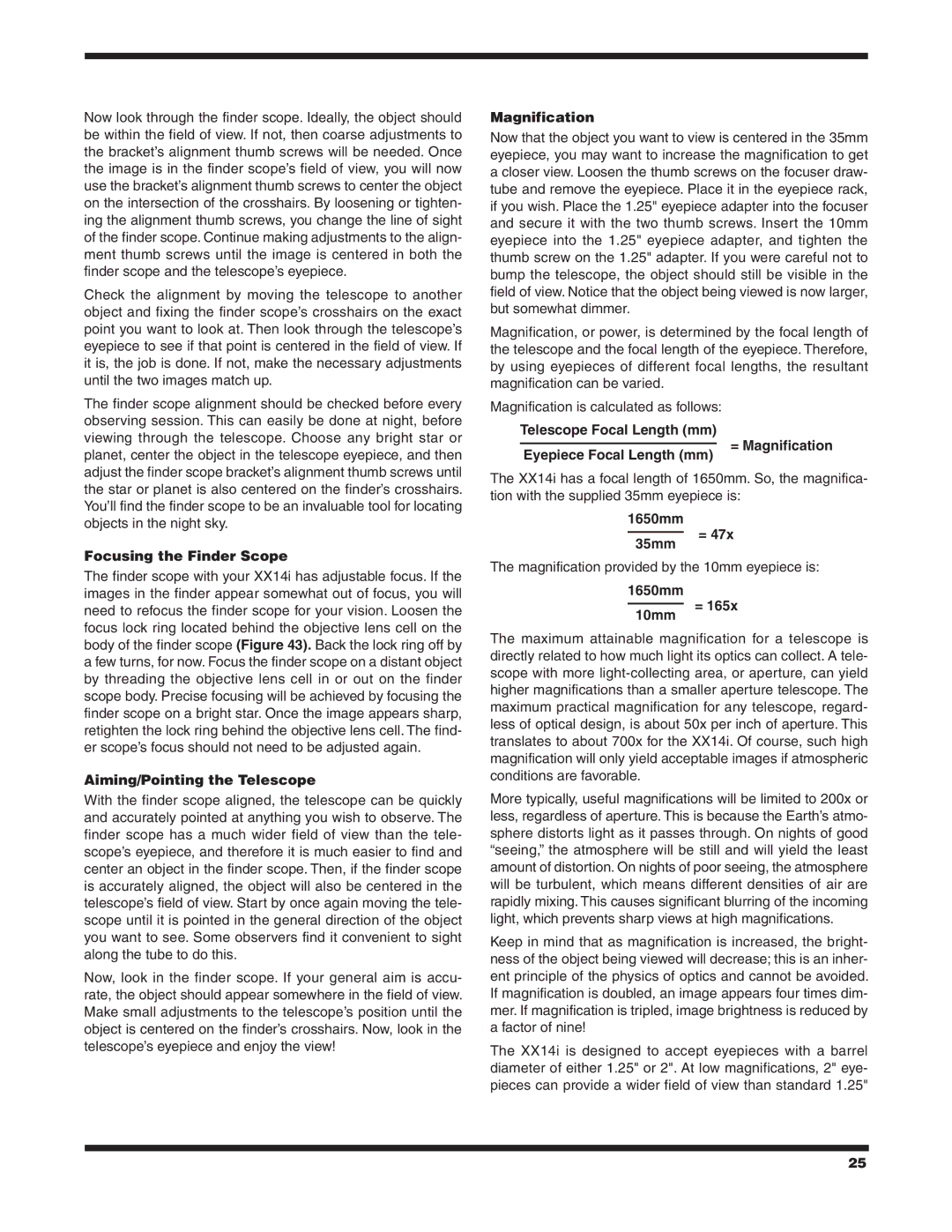
Now look through the finder scope. Ideally, the object should be within the field of view. If not, then coarse adjustments to the bracket’s alignment thumb screws will be needed. Once the image is in the finder scope’s field of view, you will now use the bracket’s alignment thumb screws to center the object on the intersection of the crosshairs. By loosening or tighten- ing the alignment thumb screws, you change the line of sight of the finder scope. Continue making adjustments to the align- ment thumb screws until the image is centered in both the finder scope and the telescope’s eyepiece.
Check the alignment by moving the telescope to another object and fixing the finder scope’s crosshairs on the exact point you want to look at. Then look through the telescope’s eyepiece to see if that point is centered in the field of view. If it is, the job is done. If not, make the necessary adjustments until the two images match up.
The finder scope alignment should be checked before every observing session. This can easily be done at night, before viewing through the telescope. Choose any bright star or planet, center the object in the telescope eyepiece, and then adjust the finder scope bracket’s alignment thumb screws until the star or planet is also centered on the finder’s crosshairs. You’ll find the finder scope to be an invaluable tool for locating objects in the night sky.
Focusing the Finder Scope
The finder scope with your XX14i has adjustable focus. If the images in the finder appear somewhat out of focus, you will need to refocus the finder scope for your vision. Loosen the focus lock ring located behind the objective lens cell on the body of the finder scope (Figure 43). Back the lock ring off by a few turns, for now. Focus the finder scope on a distant object by threading the objective lens cell in or out on the finder scope body. Precise focusing will be achieved by focusing the finder scope on a bright star. Once the image appears sharp, retighten the lock ring behind the objective lens cell. The find- er scope’s focus should not need to be adjusted again.
Aiming/Pointing the Telescope
With the finder scope aligned, the telescope can be quickly and accurately pointed at anything you wish to observe. The finder scope has a much wider field of view than the tele- scope’s eyepiece, and therefore it is much easier to find and center an object in the finder scope. Then, if the finder scope is accurately aligned, the object will also be centered in the telescope’s field of view. Start by once again moving the tele- scope until it is pointed in the general direction of the object you want to see. Some observers find it convenient to sight along the tube to do this.
Now, look in the finder scope. If your general aim is accu- rate, the object should appear somewhere in the field of view. Make small adjustments to the telescope’s position until the object is centered on the finder’s crosshairs. Now, look in the telescope’s eyepiece and enjoy the view!
Magnification
Now that the object you want to view is centered in the 35mm eyepiece, you may want to increase the magnification to get a closer view. Loosen the thumb screws on the focuser draw- tube and remove the eyepiece. Place it in the eyepiece rack, if you wish. Place the 1.25" eyepiece adapter into the focuser and secure it with the two thumb screws. Insert the 10mm eyepiece into the 1.25" eyepiece adapter, and tighten the thumb screw on the 1.25" adapter. If you were careful not to bump the telescope, the object should still be visible in the field of view. Notice that the object being viewed is now larger, but somewhat dimmer.
Magnification, or power, is determined by the focal length of the telescope and the focal length of the eyepiece. Therefore, by using eyepieces of different focal lengths, the resultant magnification can be varied.
Magnification is calculated as follows:
Telescope Focal Length (mm) | = Magnification | ||
|
| ||
Eyepiece Focal Length (mm) | |||
| |||
The XX14i has a focal length of 1650mm. So, the magnifica- tion with the supplied 35mm eyepiece is:
1650mm | = 47x | ||
|
| ||
35mm | |||
| |||
The magnification provided by the 10mm eyepiece is:
1650mm | = 165x | ||
|
| ||
10mm | |||
| |||
The maximum attainable magnification for a telescope is directly related to how much light its optics can collect. A tele- scope with more
More typically, useful magnifications will be limited to 200x or less, regardless of aperture. This is because the Earth’s atmo- sphere distorts light as it passes through. On nights of good “seeing,” the atmosphere will be still and will yield the least amount of distortion. On nights of poor seeing, the atmosphere will be turbulent, which means different densities of air are rapidly mixing. This causes significant blurring of the incoming light, which prevents sharp views at high magnifications.
Keep in mind that as magnification is increased, the bright- ness of the object being viewed will decrease; this is an inher- ent principle of the physics of optics and cannot be avoided. If magnification is doubled, an image appears four times dim- mer. If magnification is tripled, image brightness is reduced by a factor of nine!
The XX14i is designed to accept eyepieces with a barrel diameter of either 1.25" or 2". At low magnifications, 2" eye- pieces can provide a wider field of view than standard 1.25"
25
